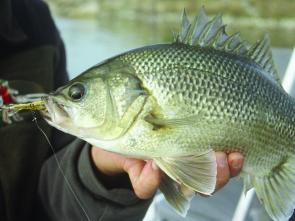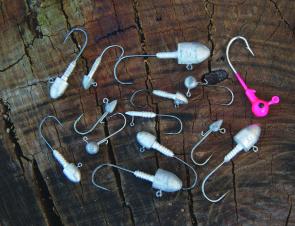Light tackle lure fishing with both soft plastics and small hard-bodied lures is a style of angling that has burst into prominence over the past decade. When you spend a lot of your time fishing with keen and experienced lure anglers, you tend to take for granted many of the basics that are essential steps for success with this style of angling.
What is common knowledge discussion at an ABT competition is almost certainly ‘double Dutch’ to a newcomer to the sport. Hopefully, the following article will cut through some of the mystery and focus on providing some basic hints for getting started in light tackle lure fishing.
Many anglers’ first consideration when buying a fishing outfit is often “will it be strong enough to a hold a big…whatever.” In light tackle luring this is a mistake. Being able to cast easily, comfortably, efficiently and accurately is the most important consideration when purchasing equipment for light tackle lure fishing. You are going to spend far more time casting than being hooked up. The lures you are throwing will be light and require a balanced outfit to be able to be cast all day.
Light tackle lure fishing is often referred to as ‘finesse fishing’. Light gear is essential to maintain a natural presentation to the targeted species. The old Black Queen with 5kg line just won’t cut it consistently. If you’re just getting started and you don’t want to lash out on a specific light lure rod, the most likely outfit in your arsenal will be a light trout style spin rod.
If the bug bites you, however, you’re going to want to go out and buy a specific lure fishing outfit. There are rods and reels on the market that have been designed for fishing specifically with soft plastics or hard-bodied lures. As with most things in life, you get what you pay for – but you should be able to get an adequate rod and reel combination for a little over $200. From then on the sky is the limit. There are outfits to suit every budget and some of the top quality light lure casting outfits are truly remarkable.
Braided lines have two huge advantages when light tackle luring. It has extra strength for its diameter (compared to monofilament), which will help to land bigger fish and get them away from tight structure. It also retains the finesse properties required for presenting small lures. There is a huge choice available, so stick to proven brands because bad braid can be expensive and frustrating to use.
Having a backing of monofilament before you spool up with the braid has a couple of benefits. Firstly it cushions the braid from the metal spool. If reel was fully spooled with braid it can slip on the metal surface under tension. Mono backing also saves on cost. ‘Top shotting’ with braid means you don’t have to fork out as much money to fill an entire spool with braid. Reversing the braid on the reel after one end gets worn also extends its life if you are budget conscious.
Braid is a highly visible line. Monofilament or fluorocarbon leaders are a must to ensure the fish doesn’t see that there are ‘strings attached’ to the interesting morsel swimming by. Expensive fluorocarbon has its benefits as leader material, but cheaper alternatives, such as light 4–10lb mono, are fine for those starting out.
If the whole leader/braid situation is putting you off there is an alternative. A quality low stretch mono in 4–6lb can do the job for anglers targeting smaller species such as bream and trout. This can be helpful for the newcomer as you don’t need to have the expense of spooling up with braid and learning the new knots involved in fishing braid. Many regular tournament anglers have a rod rigged up only with very light mono for use in situations that require extreme finesse.
Whether you are using braid or mono, tying good knots and being vigilant in checking them is important. Constant casting and retrieving can weaken previously strong knots. Checking knots regularly after landing fish or after brushing up against underwater objects ensures that everything is in order when the fish you’ve been casting for all day jumps on.
Don’t over fill your spool. Too much line can see the lightly weighted braid loop off the spool into some messy and expensive tangles.
Lure choice is perhaps not as important as it would seem. Everyone’s favourites change faster than a subcontinent cricket coach. Magic lures don’t catch fish. It’s a combination of many variables, as well as lure selection, that result in success. However, there are a few basics to remember when making your choice.
There is an immense selection of lures to choose from, including both hard-bodied and soft plastic lures. Being an experienced bait or flyfisher will make the selection easier, otherwise helpful tackle shop proprietors or a little research in magazines (e.g. VFM area reports) or on the internet will give you a few starting points for your local area and fish species.
Don’t go overboard; remember you can only throw one lure at a time. Once again you get what you pay for. It’s better to have a small selection of proven, yet more expensive, lures to put your faith in, rather than a plethora of cheaper but less effective models.
What a lure looks like on the tackle shop wall is far less important than it does in the water. There is one obvious solution here. Rig the lure, put it in the water, swim it, look at it, watch how if falls. If you think it looks like something a fish would eat then the chances are they’ll agree with you. Taking a few moments to test a lure also assists with colour selection. Lure colours, particularly for plastics, can vary under different combinations of light and watercolour.
The lure that worked for you so well on one day may not be as effective the next time. Remember to swim it and assess its suitability. You will basically be trying to achieve one of two things. Either you want to make sure you have a natural looking lure that fits in well with its environment (this is usually for when you are fishing clear water). Or else you want to ensure your lure stands out and is highly visible to the feeding fish. This is usually needed in dirty water, low light situations or when fish are feeding aggressively.
Symmetry is an important concept when rigging a soft plastic. Making sure your lure lies straight along the jig-head is important in maintaining a natural action. A lure that is not rigged straight will twist either during the drop or when retrieved, and will therefore not have the enticing natural swimming action of a well-rigged plastic. Once again, swim it after you’ve rigged it to check its action.
There are two important things to think about when selecting a jig-head. The first is to make sure the hook is the correct size for plastic being used. Make sure enough of the gape of the hook is protruding from the plastic to be able to be set inside the fish’s mouth. The weight of the jig-head should be adequate to get the lure down to the level in the water column that you intend to fish. Many don’t use enough weigh to get the lure down to where fish are feeding. Fishing up current helps the jig-head sink rate. When fishing down current, or behind a drifting boat, drag causes the lure to rise up in the water column, potentially away from your intended target.
The wide range of jig-heads can also be daunting to the newcomer. In short, the most expensive jig heads probably your best option. If you’re just beginning expect to lose a lot of jig-heads, even more so if you’re a land-based angler. Having a wide range of less expensive heads will be more beneficial than having a less extensive range of weights and sizes of expensive heads.
When tying a jig-head to a leader, any standard fishing knot that locks down hard on the eye of the hook is fine. However when attaching small hard-bodied lures to your leader, a loop knot is preferred. This helps small lures swim properly by allowing them free range of motion.
A few years ago, most keen bream anglers refitted many of their hard-bodied lures with new hooks. These days most come with good hooks – but make sure you keep them that way or replace them if they lose their edge.
Many hard-bodied lures come with split rings at the tow point. It is a good idea to remove these split rings as there is a chance of the loop passing through or cutting on the split ring under pressure when a fish is on.
Just like there is no magic lure, there is no magic retrieve. Different species, different waterways, different conditions and different lures all require some variation in the method of retrieve. Describing them all would be an article in itself. Once again common sense and experience dictate the speed and retrieve method. Some species like bream require stop, start retrieves with lots of pauses. Trout often like a slow steady one. Pelagic fish like salmon love speed one day, then a complete dead drift on another. The only rule is there is no rule, so be flexible and carefully observe the fish and the conditions you’re fishing in.
Hopefully some of these hints might help anyone wanting to get into light tackle luring. It really is a fun, effective way of fishing, where you can cover a lot of water quickly. I enjoy all types of angling, fly, game, trolling, livebaiting and so on, but I find myself more frequently attracted to this style of angling for its enjoyment and effectiveness. Give it a try some time.
Facts
LIGHT TACKLE LURING TERMINOLOGY
Soft plastic: soft realistic feeling lure that usually requires a jig-head with a single hook to be added to it.
Jighead: essentially a sinker with a hook attached that is threaded through a soft plastic.
Hard-bodied lure: A more traditional type of hard lure. Can be floating, sinking or buoyancy neutral. Treble hooks are attached.
Bib: a plastic protrusion on the front of the underside of a hard-bodied lure that pulls the lure underwater during the retrieve. The bigger and more aggressive the bib, the deeper the lure will swim.
Braid: advanced variety of line known for its low stretch and high strength for a smaller diameter compared to ordinary monofilament line.
Leader: length of line, usually clear mono or fluorocarbon, that connects to a lure to the main length of line on a reel.

Keep your gear in top condition and make your knots secure because you never know what might come along like this 4kg mulloway taken on 2kg leader.



Most people think bream when they think of light tackle luring, but many other species also are viable targets – pinky snapper in particular.

The author puts the finishing touches on another light tackle luring victim – it’s not as complicated as it sounds, so why not give it a go?

This bass smashed a small herd-bodied lure – great fun on light tackle!

Jigheads for light tackle soft lure fishing come in a variety of styles, weights and sizes – choose the one that best suits your application.




